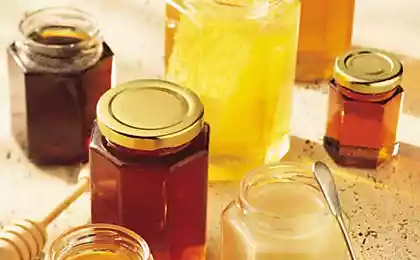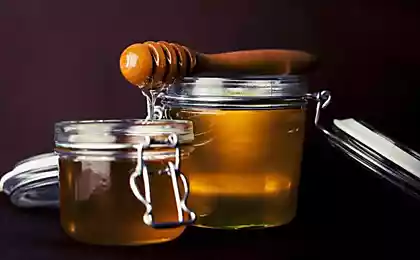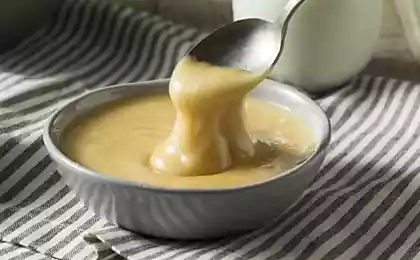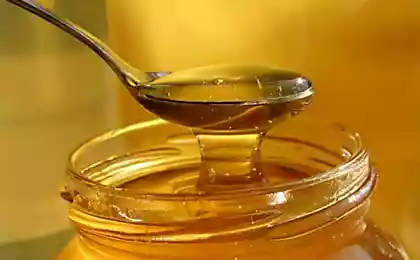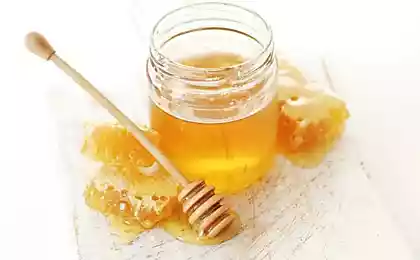645
How to choose natural bee honey
People have their methods to determine the quality of honey, for example, using chemical pencil. The bottom line is this: on paper, your finger or a spoon to apply a layer of honey and it is a chemical pencil, or a pencil dipped in the honey. It is assumed that if honey is adulterated, i.e. contains all sorts of impurities (sugar, sugar honey, as well as an increased amount of water), it will remain colored trace of the pencil. However, the researcher V. G. Chudakov in 1972 tested 36 samples of honey of different quality, including and 13 are rigged, and believes that this method of determining the genuineness of honey and assessing its quality is absolutely wrong.

There is another popular method to determine the adulteration of honey, is he in the sample on blotting paper. A small amount of honey falls on blotting paper. If after a few minutes on the reverse side of the paper will appear watery spot, it is considered a sign of tampering. Again, by V. G. Sudakovym were conducted laboratory studies of the sample, which led to the conclusion that the sample actually allows you to define almost 100% of adulterated honey, but also a part of natural honeys also fall into the category of counterfeits.
If you buy honey, look in directories, how it should look. Most importantly, it needs to have a certain flavor, honey flavor, that is a bouquet for a specific variety of honey, must conform and color.
If honey is too white, it should raise suspicion, not sugar. If the color is dark brown — not honeydew? If blunt its flavor, feel the taste of caramel — so it melted honey.
Just pay attention to the consistency of honey — it needs to fit the thickness variety, at a temperature of 20 degrees Celsius to accumulate on the spoon like a ribbon, sweet threads, interrupting at some point.
Liquid honey should arouse suspicion. Rather, it is unripe honey. It will not be stored, will ferment, since it contains a lot of water. This honey on a spoon "to wound" will not, and will just run away from it. If you buy honey in the winter, it should not be liquid, and if so, it likely warmed or diluted.

When purchasing, check the honey to ferment. While stirring should not be felt that he is not viscous, active foams, on the surface there are gas bubbles that it emits a specific sour smell and a alcohol or burnt taste.
Before purchasing a large quantity of honey, buy 100-200 gram sample.
Beware of purchasing honey from apiaries located along road routes with heavy traffic. This honey may be an increased number of lead compounds and other substances that fall on the flowers with the exhaust gases of vehicles. With nectar and pollen lead gets into the honey, and it is dangerous to the health of those who eat it.
Very bad honey collected in areas with unfavorable environment.
How to identify honey impurities?
To determine the in honey of various impurities, recommend the following methods. Pour into a transparent jar of water, add one teaspoon of honey, stir — the honey will dissolve on the bottom settles the impurity.
With the aim to detect the admixture of flour or starch in honey, pour into a jar or beaker with 3-5 ml of aqueous solution of honey (1:2) and add 3-5 drops of Lugol's iodine (or tincture of iodine). If the honey contains flour or starch, the solution turns blue.
The admixture of starch syrup (a mixture of cool water and starchy sugars) can be identified by appearance, adhesiveness and the absence of crystallization. You can still mix one part of honey with 2-3 parts distilled water, add a quarter volume of 96% alcohol and shake well. If the honey has a starch syrup, solution will milk color. After settling of the solution deposited transparent semi-fluid sticky mass (dextrin). If the impurity is absent, the solution remains transparent.
To detect the impurities of the sugar (beet) molasses and ordinary sugar can be added to a 5-10% solution of honey in water solution of silver nitrate (lapis). If you get a white precipitate of chloride of silver, it indicates the presence of impurities. If no sludge, then honey is pure. There is another method: to 5 ml of a 20% solution of honey in distilled water was added to 22.5 ml of methyl (wood) alcohol, in the formation of the abundant yellowish-white precipitate will become clear that the honey contains sugar syrup.
For the detection of impurities inverted sugar (honey nytrety) a rather complicated method: grind 5 g of honey with a small amount of ether (which dissolve the cleavage products of fructose), then the ethereal solution is filtered into a bowl, evaporated to dryness and to the residue add 2-3 drops of freshly prepared 1% solution of resorcinol in concentrated hydrochloric acid (SP. weight 1,125 g). If the mixture will turn orange (to cherry red) color, it means that there is an inverted sugar.
A higher percentage of sucrose in honey that can be installed in the laboratory, says its the poor quality: natural flower honey sucrose: not more than 5%, no more than 10% — in honeydew. The better the quality of honey, the less of sucrose. "Sugar" honey has its own organoleptic characteristics: smell of old comb, sweet bland flavor, liquid consistency (if fresh), long-term storage becomes thick, sticky, sticky.
"Sugar" honey (bees were fed or fed with sugar), like all natural honey, characterized by the absence of vitamins, organic acids, protein and aromatic substances, mineral salts. In sugar honey main element is silicon, and are virtually absent the rest of the salt, there are only traces of them. Natural honey — on the contrary.
If the honey is not kristallizuetsya, we can assume that there is an admixture of potato molasses.
In order to detect the admixture of honeydew honey should be in a glass pour 1 part of aqueous solution of honey (1:1) and add 2 parts lime water, then heat the mixture to a boil. If there are flakes of brown color, drop down into the sediment, it indicates the presence of impurities honeydew honey.
A SET OF EXPRESS TESTS OF HONEY ON QUALITY WHEN BUYING
(Some items repeat the above, but repetition is the mother of learning, as any rational adult would have to let himself be fooled by every roguish crooks, and in all cases be able to choose the normal quality products)
Is it possible to buy honey with it? Only, if you are sure what you are buying. Selling honey in the store is also not a guarantee of its quality.
The only real guarantee of the quality of the purchased honey is a personal acquaintance with the beekeeper, confidence in his integrity and the knowledge that his apiary is located in a prosperous area. Therefore, it is best to buy honey from a friend of the beekeeper right in the apiary.
The most common fake honey — sugar syrup. This syrup is often diluted with unripe honey to give it the missing sweetness.
First, the honey must be Mature. Because the bees working on the nectar for about a week: evaporated water, enriched with enzymes that break down complex sugars into simple. During this time the honey is extracted. The finished product seal bees wax caps, this honey has all its useful properties and can be stored for a long time.
Very often beekeepers siphon off the honey during the honey flow, without waiting for his aging, due to the lack of combs. The water content of this honey is sometimes twice the norm, he is a little enriched with enzymes and sucrose, quickly turns sour.
To determine the maturity of fresh natasharusoc honey, its temperature is adjusted to 20 gr. With stirring spoon. Then take a spoon and start to rotate. Mature honey screwed onto it. From the time the honey can be sugar, it is normal and does not affect neither the taste nor the aroma or on the healing qualities of honey.
With the help of simple tests can determine whether adulterated honey:
— The flour and starch is determined by adding a small amount diluted with water of honey a drop of iodine. If the solution turned blue, honey with flour or cornstarch.
— If adding of vinegar solution hissing — honey is Mel.
— If in 5-10% aqueous solution of honey, when you add a small amount of a solution of silver nitrate around the droplets is formed turbidity, and falls white precipitate was added sugar.
How can you determine the quality of honey?
Color.
Each variety of honey has its own color, a characteristic. Flower honey — light yellow, lime — amber, ash, clear as water, buckwheat has different shades of brown. Pure honey without impurities, as a rule, transparent, whatever color it may be.
Honey, having in its composition additives (sugar, starch, and other impurities), is unclear, and if you look closely, it is possible to detect the precipitate.
Flavor.
Real honey differs fragrant aroma. The smell makes the difference. Honey mixed with sugar has no flavor, and the taste is close to the taste of sugar water.
Viscosity.
Take the honey sample, lowering in the capacity of a thin stick. If it's a real honey, he dragged after stick long continuous thread, and when this thread is interrupted, then it is entirely omitted, forming on the surface of the medical tower, the pagoda, which then slowly disperse.
The fake honey will behave like glue: is abundantly drain and drip down from the sticks, forming a spray.
Consistency.
In this honey, she is thin, tender. Honey is easily pounded between fingers and absorbed into the skin, you will not tell about the fake. Do fake honey rough structure, with the rubbing on the fingers are lumps.
Before buying on the market of honey in reserve, take the products you have 2-3 regular sellers. To start at 100 grams. At home follow the recommended sample quality and then buy it in store from these sellers.
Check have you added to the honey water and sugar.
On not glued a piece of low-grade paper (such as newspaper or toilet) which absorbs moisture, drip honey. If it will spread across the paper, forming a wet spot, or even bleed through is fake honey.
Determine whether honey and starch.
To do this, put in the glass some honey, pour boiling water, stir and refrigerate. After that, squeeze out a few drops of iodine. If the part turns blue, then the honey added starch. This is fake honey.
Find out if honey and other impurities.
To do this, take a hot wire from stainless steel (you can heat it in the flame of a lighter) and dip it in honey. If it hangs, adhesive foreign mass — before you fake honey, if the wire remains pure — natural honey or in other words, full.
What you should pay attention to when buying honey?
Honey, including the sale, cannot be stored in a metal container because the acid contained in the composition, can give oxidation. This will lead to an increase in the content of heavy metals in it, and to reduce nutrients. This honey can cause discomfort in the stomach and even lead to poisoning.
Conscientious sellers keep honey in glass, earthenware, porcelain, ceramic and wooden utensils. If you see that the honey sold from metal containers — just go away.
How else can you distinguish a fake?
In a Cup of warm weak tea, add a little that you bought under the guise of honey. If you are not deceived, the tea will darken, but at the bottom there is formed a precipitate.
Over time honey becomes cloudy and thickens (candied) — this is a sure sign of good quality. Some may mistakenly believe that honey is spoiled.
Sometimes honey during storage is divided into two layers: it gets denser on the bottom, and the top remains liquid. This suggests that he is immature, and therefore it should be eaten as quickly as possible — unripe honey is stored for a few months.
Careless beekeepers do not take out the bee to collect nectar, and just feed them sugar. Sugar honey cinnamon. Nothing useful in it. This "sugar" honey is unnaturally white.
In this med free water is absent in Mature honey water (about 20%) is associated in a true saturated solution. Honey with sugar syrup has a high moisture content, it can be checked in the following way: dip in honey a piece of bread, and after 8-10 minutes, take it out. Quality honey bread hardens. If on the contrary, softened or even spread in front of you is nothing like sugar syrup.
But the market nobody will allow you to conduct similar experiments, but give it a try. Often on a small piece of paper dripping honey for tasting. This is enough to conduct another experiment. Gathering the honey on the market, take an indelible pencil. Pencil spread honey on a piece of paper, you can smudge with your finger, and the "honey" strip try to write something indelible. If a few seconds will appear the inscription or stains of blue color, can confidently and loudly inform the seller (to heard other buyers) that the product contains starch or flour. If there is no chemical pencil fit and a drop of iodine. The same blue shade offered honey accurately determine the starch and flour in the product.
Honey — mountain or, let say, plain?
Do not fall for the bait when you try to convince that mountain better than the honey that the bees collect in our area. No special advantages at mountain honey in front of the "flat," no. The quality of honey and concentration of nutrients in it depends on the honesty and knowledge of the beekeeper, and environmental situation of the area collect honey. Here, however, there is a difference between honey harvested in a clean environment, and the fact that bees collected from the flower beds of an industrial enterprise. But it all depends on the beekeeper. The conscience should not allow him to earn the "industrial" honey.
From sellers of honey there are several above designed for gullible buyers.
First, plug your ears and do not listen to what they tell you. Check everything yourself. Of course, a bunch of liars can come across an honest seller, but how do you know that honest is the one who stands before you? Try honey not only from above but from the bottom of the jar. Feel free to stick your spoon in the jar and don't listen to sellers that will begin to shout: "don't waste your product!"
Unheated honey and fresh transparent, and sugar is an effective antiseptic, and a clean spoon in the Bank can not to mess it up. Another thing, if the bottom was not honey, or the honey has been heated, which led to the loss of all its antiseptic and other medicinal properties.
Do not buy on the market med without checking or rolled up. The fact that honey is best stored, rolled up the tin lid is a myth. Simple enough zavertyvanija or tight plastic cover.
Crystallization of (sugared) — natural honey process, which does not affect the quality and composition of nutrients. Don't be fooled by the crystallized honey. Don't come the next day to the seller, who promised you nezakristallizovannye honey. Will bring the same, but heated. And warm the honey in any case is impossible, since it turns it into a simple sweet substance, devoid of so many useful properties!
Real honey has the following characteristics:
Quality honey rolls from the spoon too quickly. Take a tablespoon of honey and a fast circular motion, flip the spoon a few times. Honey will be screwed to it, almost draining it in a jar.
Immerse the spoon in a container of honey. Pulling out the spoon, take advantage of the nature of the flow off of honey. Good will form a ribbon, take the hill, and on the surface it bubbles.
All types of honey are sweet, but some varieties have a specific taste. For example, tobacco, chestnut and willow varieties have a bitter taste, but Heather is my preference. Any deviation in the taste of honey show that it was substandard. Other defects of the palate can be associated with the presence of impurities. Excessive acidity may be associated with the beginning of the fermentation, the aroma of caramel is the result of heating, the obvious bitterness — incorrect storage conditions of a defective product.
The color of the honey depends solely on grades. It can be all shades of brown and yellow colors. Don't be scared pale yellowish, slightly cloudy honey — it is normal for constant for some time acacia honey, because it is candy very slowly and for a long time — sometimes fully only at the end of winter (but be sure to try it and decide that this is acacia honey). Other types natasharusoc honey mutualist is not inherent, because the process of saccharification (clouding and hardening) occurs rapidly — only that were transparent and all of a sudden (2-4 weeks after the bribes — the period depends on the type of honey) from whole sugar.
Another very simple quick check: it is necessary to drip the honey onto the paper and burn it. Paper burns around, but the real quality honey it does not burn, does not melt and does not brown. If the honey has started to melt — so the bees were fed sugar syrup, and if brown is so diluted with sugar.

© infographics RIA Novosti
источник:aromatmeda.ru
Source: /users/1077

There is another popular method to determine the adulteration of honey, is he in the sample on blotting paper. A small amount of honey falls on blotting paper. If after a few minutes on the reverse side of the paper will appear watery spot, it is considered a sign of tampering. Again, by V. G. Sudakovym were conducted laboratory studies of the sample, which led to the conclusion that the sample actually allows you to define almost 100% of adulterated honey, but also a part of natural honeys also fall into the category of counterfeits.
If you buy honey, look in directories, how it should look. Most importantly, it needs to have a certain flavor, honey flavor, that is a bouquet for a specific variety of honey, must conform and color.
If honey is too white, it should raise suspicion, not sugar. If the color is dark brown — not honeydew? If blunt its flavor, feel the taste of caramel — so it melted honey.
Just pay attention to the consistency of honey — it needs to fit the thickness variety, at a temperature of 20 degrees Celsius to accumulate on the spoon like a ribbon, sweet threads, interrupting at some point.
Liquid honey should arouse suspicion. Rather, it is unripe honey. It will not be stored, will ferment, since it contains a lot of water. This honey on a spoon "to wound" will not, and will just run away from it. If you buy honey in the winter, it should not be liquid, and if so, it likely warmed or diluted.

When purchasing, check the honey to ferment. While stirring should not be felt that he is not viscous, active foams, on the surface there are gas bubbles that it emits a specific sour smell and a alcohol or burnt taste.
Before purchasing a large quantity of honey, buy 100-200 gram sample.
Beware of purchasing honey from apiaries located along road routes with heavy traffic. This honey may be an increased number of lead compounds and other substances that fall on the flowers with the exhaust gases of vehicles. With nectar and pollen lead gets into the honey, and it is dangerous to the health of those who eat it.
Very bad honey collected in areas with unfavorable environment.
How to identify honey impurities?
To determine the in honey of various impurities, recommend the following methods. Pour into a transparent jar of water, add one teaspoon of honey, stir — the honey will dissolve on the bottom settles the impurity.
With the aim to detect the admixture of flour or starch in honey, pour into a jar or beaker with 3-5 ml of aqueous solution of honey (1:2) and add 3-5 drops of Lugol's iodine (or tincture of iodine). If the honey contains flour or starch, the solution turns blue.
The admixture of starch syrup (a mixture of cool water and starchy sugars) can be identified by appearance, adhesiveness and the absence of crystallization. You can still mix one part of honey with 2-3 parts distilled water, add a quarter volume of 96% alcohol and shake well. If the honey has a starch syrup, solution will milk color. After settling of the solution deposited transparent semi-fluid sticky mass (dextrin). If the impurity is absent, the solution remains transparent.
To detect the impurities of the sugar (beet) molasses and ordinary sugar can be added to a 5-10% solution of honey in water solution of silver nitrate (lapis). If you get a white precipitate of chloride of silver, it indicates the presence of impurities. If no sludge, then honey is pure. There is another method: to 5 ml of a 20% solution of honey in distilled water was added to 22.5 ml of methyl (wood) alcohol, in the formation of the abundant yellowish-white precipitate will become clear that the honey contains sugar syrup.
For the detection of impurities inverted sugar (honey nytrety) a rather complicated method: grind 5 g of honey with a small amount of ether (which dissolve the cleavage products of fructose), then the ethereal solution is filtered into a bowl, evaporated to dryness and to the residue add 2-3 drops of freshly prepared 1% solution of resorcinol in concentrated hydrochloric acid (SP. weight 1,125 g). If the mixture will turn orange (to cherry red) color, it means that there is an inverted sugar.
A higher percentage of sucrose in honey that can be installed in the laboratory, says its the poor quality: natural flower honey sucrose: not more than 5%, no more than 10% — in honeydew. The better the quality of honey, the less of sucrose. "Sugar" honey has its own organoleptic characteristics: smell of old comb, sweet bland flavor, liquid consistency (if fresh), long-term storage becomes thick, sticky, sticky.
"Sugar" honey (bees were fed or fed with sugar), like all natural honey, characterized by the absence of vitamins, organic acids, protein and aromatic substances, mineral salts. In sugar honey main element is silicon, and are virtually absent the rest of the salt, there are only traces of them. Natural honey — on the contrary.
If the honey is not kristallizuetsya, we can assume that there is an admixture of potato molasses.
In order to detect the admixture of honeydew honey should be in a glass pour 1 part of aqueous solution of honey (1:1) and add 2 parts lime water, then heat the mixture to a boil. If there are flakes of brown color, drop down into the sediment, it indicates the presence of impurities honeydew honey.
A SET OF EXPRESS TESTS OF HONEY ON QUALITY WHEN BUYING
(Some items repeat the above, but repetition is the mother of learning, as any rational adult would have to let himself be fooled by every roguish crooks, and in all cases be able to choose the normal quality products)
Is it possible to buy honey with it? Only, if you are sure what you are buying. Selling honey in the store is also not a guarantee of its quality.
The only real guarantee of the quality of the purchased honey is a personal acquaintance with the beekeeper, confidence in his integrity and the knowledge that his apiary is located in a prosperous area. Therefore, it is best to buy honey from a friend of the beekeeper right in the apiary.
The most common fake honey — sugar syrup. This syrup is often diluted with unripe honey to give it the missing sweetness.
First, the honey must be Mature. Because the bees working on the nectar for about a week: evaporated water, enriched with enzymes that break down complex sugars into simple. During this time the honey is extracted. The finished product seal bees wax caps, this honey has all its useful properties and can be stored for a long time.
Very often beekeepers siphon off the honey during the honey flow, without waiting for his aging, due to the lack of combs. The water content of this honey is sometimes twice the norm, he is a little enriched with enzymes and sucrose, quickly turns sour.
To determine the maturity of fresh natasharusoc honey, its temperature is adjusted to 20 gr. With stirring spoon. Then take a spoon and start to rotate. Mature honey screwed onto it. From the time the honey can be sugar, it is normal and does not affect neither the taste nor the aroma or on the healing qualities of honey.
With the help of simple tests can determine whether adulterated honey:
— The flour and starch is determined by adding a small amount diluted with water of honey a drop of iodine. If the solution turned blue, honey with flour or cornstarch.
— If adding of vinegar solution hissing — honey is Mel.
— If in 5-10% aqueous solution of honey, when you add a small amount of a solution of silver nitrate around the droplets is formed turbidity, and falls white precipitate was added sugar.
How can you determine the quality of honey?
Color.
Each variety of honey has its own color, a characteristic. Flower honey — light yellow, lime — amber, ash, clear as water, buckwheat has different shades of brown. Pure honey without impurities, as a rule, transparent, whatever color it may be.
Honey, having in its composition additives (sugar, starch, and other impurities), is unclear, and if you look closely, it is possible to detect the precipitate.
Flavor.
Real honey differs fragrant aroma. The smell makes the difference. Honey mixed with sugar has no flavor, and the taste is close to the taste of sugar water.
Viscosity.
Take the honey sample, lowering in the capacity of a thin stick. If it's a real honey, he dragged after stick long continuous thread, and when this thread is interrupted, then it is entirely omitted, forming on the surface of the medical tower, the pagoda, which then slowly disperse.
The fake honey will behave like glue: is abundantly drain and drip down from the sticks, forming a spray.
Consistency.
In this honey, she is thin, tender. Honey is easily pounded between fingers and absorbed into the skin, you will not tell about the fake. Do fake honey rough structure, with the rubbing on the fingers are lumps.
Before buying on the market of honey in reserve, take the products you have 2-3 regular sellers. To start at 100 grams. At home follow the recommended sample quality and then buy it in store from these sellers.
Check have you added to the honey water and sugar.
On not glued a piece of low-grade paper (such as newspaper or toilet) which absorbs moisture, drip honey. If it will spread across the paper, forming a wet spot, or even bleed through is fake honey.
Determine whether honey and starch.
To do this, put in the glass some honey, pour boiling water, stir and refrigerate. After that, squeeze out a few drops of iodine. If the part turns blue, then the honey added starch. This is fake honey.
Find out if honey and other impurities.
To do this, take a hot wire from stainless steel (you can heat it in the flame of a lighter) and dip it in honey. If it hangs, adhesive foreign mass — before you fake honey, if the wire remains pure — natural honey or in other words, full.
What you should pay attention to when buying honey?
Honey, including the sale, cannot be stored in a metal container because the acid contained in the composition, can give oxidation. This will lead to an increase in the content of heavy metals in it, and to reduce nutrients. This honey can cause discomfort in the stomach and even lead to poisoning.
Conscientious sellers keep honey in glass, earthenware, porcelain, ceramic and wooden utensils. If you see that the honey sold from metal containers — just go away.
How else can you distinguish a fake?
In a Cup of warm weak tea, add a little that you bought under the guise of honey. If you are not deceived, the tea will darken, but at the bottom there is formed a precipitate.
Over time honey becomes cloudy and thickens (candied) — this is a sure sign of good quality. Some may mistakenly believe that honey is spoiled.
Sometimes honey during storage is divided into two layers: it gets denser on the bottom, and the top remains liquid. This suggests that he is immature, and therefore it should be eaten as quickly as possible — unripe honey is stored for a few months.
Careless beekeepers do not take out the bee to collect nectar, and just feed them sugar. Sugar honey cinnamon. Nothing useful in it. This "sugar" honey is unnaturally white.
In this med free water is absent in Mature honey water (about 20%) is associated in a true saturated solution. Honey with sugar syrup has a high moisture content, it can be checked in the following way: dip in honey a piece of bread, and after 8-10 minutes, take it out. Quality honey bread hardens. If on the contrary, softened or even spread in front of you is nothing like sugar syrup.
But the market nobody will allow you to conduct similar experiments, but give it a try. Often on a small piece of paper dripping honey for tasting. This is enough to conduct another experiment. Gathering the honey on the market, take an indelible pencil. Pencil spread honey on a piece of paper, you can smudge with your finger, and the "honey" strip try to write something indelible. If a few seconds will appear the inscription or stains of blue color, can confidently and loudly inform the seller (to heard other buyers) that the product contains starch or flour. If there is no chemical pencil fit and a drop of iodine. The same blue shade offered honey accurately determine the starch and flour in the product.
Honey — mountain or, let say, plain?
Do not fall for the bait when you try to convince that mountain better than the honey that the bees collect in our area. No special advantages at mountain honey in front of the "flat," no. The quality of honey and concentration of nutrients in it depends on the honesty and knowledge of the beekeeper, and environmental situation of the area collect honey. Here, however, there is a difference between honey harvested in a clean environment, and the fact that bees collected from the flower beds of an industrial enterprise. But it all depends on the beekeeper. The conscience should not allow him to earn the "industrial" honey.
From sellers of honey there are several above designed for gullible buyers.
First, plug your ears and do not listen to what they tell you. Check everything yourself. Of course, a bunch of liars can come across an honest seller, but how do you know that honest is the one who stands before you? Try honey not only from above but from the bottom of the jar. Feel free to stick your spoon in the jar and don't listen to sellers that will begin to shout: "don't waste your product!"
Unheated honey and fresh transparent, and sugar is an effective antiseptic, and a clean spoon in the Bank can not to mess it up. Another thing, if the bottom was not honey, or the honey has been heated, which led to the loss of all its antiseptic and other medicinal properties.
Do not buy on the market med without checking or rolled up. The fact that honey is best stored, rolled up the tin lid is a myth. Simple enough zavertyvanija or tight plastic cover.
Crystallization of (sugared) — natural honey process, which does not affect the quality and composition of nutrients. Don't be fooled by the crystallized honey. Don't come the next day to the seller, who promised you nezakristallizovannye honey. Will bring the same, but heated. And warm the honey in any case is impossible, since it turns it into a simple sweet substance, devoid of so many useful properties!
Real honey has the following characteristics:
Quality honey rolls from the spoon too quickly. Take a tablespoon of honey and a fast circular motion, flip the spoon a few times. Honey will be screwed to it, almost draining it in a jar.
Immerse the spoon in a container of honey. Pulling out the spoon, take advantage of the nature of the flow off of honey. Good will form a ribbon, take the hill, and on the surface it bubbles.
All types of honey are sweet, but some varieties have a specific taste. For example, tobacco, chestnut and willow varieties have a bitter taste, but Heather is my preference. Any deviation in the taste of honey show that it was substandard. Other defects of the palate can be associated with the presence of impurities. Excessive acidity may be associated with the beginning of the fermentation, the aroma of caramel is the result of heating, the obvious bitterness — incorrect storage conditions of a defective product.
The color of the honey depends solely on grades. It can be all shades of brown and yellow colors. Don't be scared pale yellowish, slightly cloudy honey — it is normal for constant for some time acacia honey, because it is candy very slowly and for a long time — sometimes fully only at the end of winter (but be sure to try it and decide that this is acacia honey). Other types natasharusoc honey mutualist is not inherent, because the process of saccharification (clouding and hardening) occurs rapidly — only that were transparent and all of a sudden (2-4 weeks after the bribes — the period depends on the type of honey) from whole sugar.
Another very simple quick check: it is necessary to drip the honey onto the paper and burn it. Paper burns around, but the real quality honey it does not burn, does not melt and does not brown. If the honey has started to melt — so the bees were fed sugar syrup, and if brown is so diluted with sugar.

© infographics RIA Novosti
источник:aromatmeda.ru
Source: /users/1077
